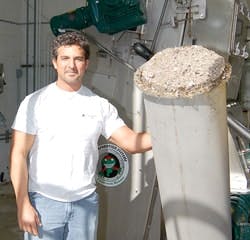Screening More Efficiently
A few years ago, the Hammonton Wastewater Treatment Plant in Hammonton, N.J., faced constant problems with rags, trash and plastics passing through a rusty, old bar screen at the wastewater treatment plant and into the oxidation ditch and final clarifier.
After years spent unclogging pumps, untangling the UV system and clearing trash, plant managers decided to find a more efficient screening system. After evaluating several screens, the team selected the Monster Separation System from JWC Environmental of Costa Mesa, Calif. The perforated-plate fine screen offered the best possible capture efficiency and fit into the current channel configuration.
Anthony DeCicco, superintendent of the facility, which averages 1 million gal per day (mgd), reported significant operational and maintenance benefits from the new, multifaceted separation system. Incorporating the screenings washer also eliminated an old, messy screw conveyor, which helped clean up and control odors inside the headworks area.
“Our operation was experiencing clogging from floatables, hair and rags passing through the old bar screen,” DeCicco said. “We had been burdened for years by paper, plastic and latex materials, especially grease from saturated fats. Since the installation of the new system in September 2006, more solids are being captured, and we have had little to no maintenance.”
The Grease Balls
The facility can handle a peak flow of 7 mgd and serves a population of more than 12,000, with a large number of high grease-producing restaurants. These fats, oil and grease (FOG) arrived at the plant in large, partially solidified globs that would pass right through the old bar screen and eventually clog the pumps. Now, many of the grease balls are removed by the new separation system and put through the screenings washer.
The fine screen system eliminated several trouble spots for DeCicco and his crew. They were able to remove a manual screen located at the plant’s final discharge point that captured trash that the old bar screen missed. Grease, latex products and hair were significant culprits in clogging machinery and leading to hours of messy, backbreaking labor. The new screen eliminates all of this, allowing DeCicco and his crew to focus on more important parts of the facility.
The installation of the new screen was the first upgrade to the plant, which was originally built in 1994. Hammonton, known as the “Blueberry Capital of the World,” has more than 4,000 domestic connections and growth continues to be steady. That growth, which includes increases in blueberry farming and the restaurant business, creates a noticeably greater amount of fats, oil and grease entering the sewage system.
The Monsters of Hammonton
Aside from the Monster Separation System , Hammonton has been a long-time user of Muffin Monster pump station grinders. Seven are located at stations throughout the city. The powerful dual-shafted grinders shred rags, latex, clothing, branches and other debris into small particles that flow easily through pumps and pipes. With the help of the grinders, the pump stations have remained free flowing and clear.
“Hammonton has an amazingly simple and cost-effective way of dealing with trash in the sewer system,” said Fritz Egger, JWC’s director of marketing. “They don’t screen out trash at the pump station so they save on hauling costs, and they shouldn’t face any clogged pumps with grinders installed, so they’re maintenance staff can focus on tasks other than de-ragging pumps.”
The grinders shred trash at the pump station and send it on to the plant’s preliminary treatment area where the Finescreen takes the trash out and the screenings washer cleans it, preparing it for the landfill.
“It’s the most efficient way of getting trash out of the sewers so the rest of the treatment process can do its job,” Egger said.
The screenings washer system is designed to provide screenings of unparalleled dryness and cleanliness. Removed solids typically contain up to 50% dry solids, are reduced in volume by 80% or more and are significantly lighter than typical washer-compactor discharge.
In the Screenings Washer Monster part of the system, solids are flushed through a grinder for size reduction, helping to expose more surface area for improved washing and fecal matter removal. A second spray wash and an auger move the solids into the compaction zone while soft organics are liquefied and pass through the perforated trough, returning to the plant’s waste stream. The captured solids are compacted, dewatered and discharged as a cake into a dumpster and are ready for disposal.
